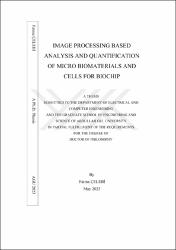| dc.contributor.author | Çelebi, Fatma | |
| dc.date.accessioned | 2024-01-11T08:21:49Z | |
| dc.date.available | 2024-01-11T08:21:49Z | |
| dc.date.issued | 2023 | en_US |
| dc.date.submitted | 2023-05-10 | |
| dc.identifier.uri | https://hdl.handle.net/20.500.12573/1884 | |
| dc.description.abstract | Quantification of tumor cells is essential for early cancer detection and progression tracking. Multiple techniques have been devised to detect tumor cells. In addition to conventional laboratory instruments, several biochip-based techniques have been devised for this purpose. Our biochip design incorporates micron-sized immunomagnetic beads and micropad arrays, necessitating automated detection and quantification not only of cells but also of the micropads and immunomagnetic beads. The primary function of the biochip is to simultaneously acquire target cells with distinct antigens. As a readout technique for the biochip, this study devised a digital image processing-based method for quantifying leukemia cells, immunomagnetic beads, and micropads. Images were acquired on the chip using bright-field microscopy with image objectives of 20X and 40X. Conventional image processing methods, machine learning methods, and deep learning methods were used to analyze the images. To quantify targets in the images captured by a bright-field microscope, color- and size-based object recognition and machine learning-based methods were first implemented. Secondly, color- and size-based object detection and object segmentation methods were implemented to detect structures in bright-field optical microscope images acquired from the biochip. Third, segmentation of the minimal residual disease (MRD) using deep learning. Implemented biochip images comprised of leukemic cells, immunomagnetic beads, and micropads. Moreover, mesenchymal stem cells (MSCs) are stem cells with the capacity for multilineage differentiation and self-renewal. Estimating the proportion of senescent cells is therefore essential for clinical applications of MSCs. In this study, a self-supervised learning (SSL)-based method for segmenting and quantifying the density of cellular senescence was implemented, which can perform well despite the small size of the labeled dataset. | en_US |
| dc.description.abstract | Tümör hücrelerinin miktarının belirlenmesi, kanserin erken tespiti ve ilerlemesinin izlenmesi için çok önemlidir. Tümör hücrelerini saptamak için çeşitli yöntemler geliştirilmiştir. Standart tezgah üstü cihazların yanı sıra, bu amaç için çeşitli biyoçip tabanlı yöntemler geliştirilmiştir. Biyoçip tasarımımız, mikro ped dizileri ile birlikte mikron boyutunda immünomanyetik boncuklar içerir, bu nedenle yalnızca hücrelerin değil aynı zamanda mikro pedlerin ve immünomanyetik boncukların otomatik olarak algılanmasını ve ölçülmesini gerektirir. Biyoçipin temel amacı, farklı antijenlere sahip hedef hücreleri aynı anda yakalamaktır. Bu çalışmada, biyoçip için bir okuma yöntemi olarak lösemi hücrelerini, immünomanyetik boncukları ve mikro pedleri ölçmek için dijital görüntü işleme tabanlı bir yöntem geliştirilmiştir. Çipte, parlak alan mikroskopi ile 20X ve 40X görüntüler elde edildi. Görüntüler, geleneksel görüntü işleme yöntemleri, makine öğrenmesi yöntemleri ve derin öğrenme yöntemleri ile analiz edilmiştir. Parlak alan mikroskobu ile kaydedilen görüntülerdeki hedefleri ölçmek için renk ve boyut tabanlı nesne tanımlama ve makine öğrenme tabanlı yöntemler uygulandı. Parlak alan optik mikroskobu ile biyoçipten elde edilen görüntülerdeki yapıları tespit etmek için renk ve boyut tabanlı nesne algılama ve nesne bölütleme yöntemleri uygulandı. Lösemik hücreler, immünomanyetik boncuklar ve mikro pedlerden oluşan MRD Biochip görüntülerine derin öğrenme tabanlı segmentasyon uygulandı. Ayrıca, çok soylu farklılaşma ve kendini yenileme potansiyeline sahip mezenkimal kök hücrelerde, yaşlanan hücrelerin yüzdesinin tahmin edilmesi, klinik uygulamalar için kritik öneme sahiptir. Bu çalışmada, sınırlı boyutta etiketlenmiş veri kümesiyle bile verimli bir şekilde performans gösterebilen hücresel yaşlanma yoğunluğunu bölümlemek ve ölçmek için kendinden denetimli öğrenme tabanlı yöntem uygulandı. | en_US |
| dc.language.iso | eng | en_US |
| dc.publisher | Abdullah Gül Üniversitesi, Fen Bilimleri Enstitüsü | en_US |
| dc.rights | info:eu-repo/semantics/openAccess | en_US |
| dc.subject | Leukemia Cells | en_US |
| dc.subject | Image-Processing | en_US |
| dc.subject | Machine Learning | en_US |
| dc.subject | Deep Learning | en_US |
| dc.subject | Immunomagnetic Beads | en_US |
| dc.subject | Support Vector Machine | en_US |
| dc.subject | MRD Biochip | en_US |
| dc.subject | Bright-Field Microscope | en_US |
| dc.subject | Semantic Segmentation | en_US |
| dc.subject | Transfer Learning | en_US |
| dc.subject | Self-Supervised Learning | en_US |
| dc.subject | Instance Segmentation | en_US |
| dc.subject | Cellular Senescence | en_US |
| dc.subject | Lösemi Hücreleri | en_US |
| dc.subject | Görüntü İşleme | en_US |
| dc.subject | Makine Öğrenmesi | en_US |
| dc.subject | Derin Öğrenme | en_US |
| dc.subject | MRD Biyoçip | en_US |
| dc.subject | Semantik Segmentasyon | en_US |
| dc.subject | Transfer Öğrenimi | en_US |
| dc.subject | Kendinden Denetimli Öğrenme | en_US |
| dc.subject | Parlak Alan Mikroskopu | en_US |
| dc.subject | Örnek Segmentasyonu | en_US |
| dc.subject | Hücresel Yaşlanma | en_US |
| dc.subject | Magnetik Boncuk | en_US |
| dc.title | Image processing based analysis and quantification of micro biomaterials and cells for biochip | en_US |
| dc.title.alternative | Biyoçipler için mikro biyomalzemelerin ve hücrelerin görüntü işleme yöntemleri ile otomatik olarak sayılması ve analizi | en_US |
| dc.type | doctoralThesis | en_US |
| dc.contributor.department | AGÜ, Fen Bilimleri Enstitüsü, Elektrik ve Bilgisayar Mühendisliği Ana Bilim Dalı | en_US |
| dc.contributor.authorID | 0000-0001-7472-8297 | en_US |
| dc.relation.publicationcategory | Tez | en_US |


















